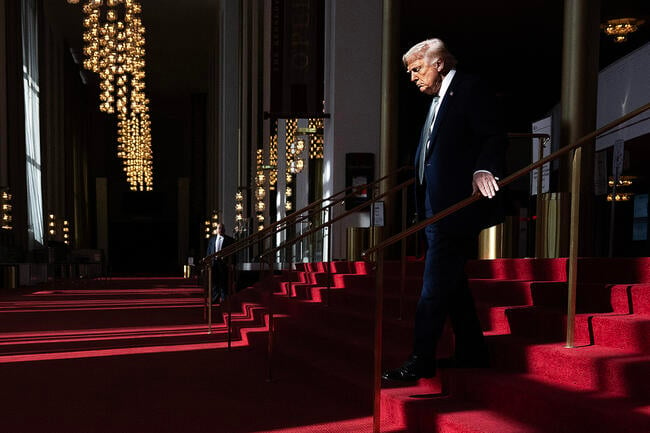You have /5 articles left.
Sign up for a free account or log in.

President Donald Trump has targeted higher education on numerous fronts since beginning his second term, leaving those in the sector nervous about long-term impacts.
Jim Watson/AFP/Getty Images
It’s been 100 days since Donald Trump entered the Oval Office for a second time. When he was elected, attacking higher education had already become a conservative shibboleth, but the new administration’s plans for the sector were still murky. Would they take up the torches and pitchforks that Republicans in states like Florida and Texas hoisted against DEI spending and student protesters, or would they turn their focus elsewhere?
Within a month, the administration had launched a barrage of attacks on colleges and universities, accusing them of fostering antisemitism. Trump officials slashed federal grants first to Columbia University and then to many more, demanding institutions capitulate to sweeping demands in order to restore funding. They gutted the Education Department and fired most of the staff responsible for higher ed policy and oversight. They declared DEI programs unconstitutional and launched investigations into colleges they suspected of favoring minority students in admissions. University counsels’ offices were inundated with unprecedented legal questions, budgets stood in limbo and administrators walked a precarious tightrope between appeasement and resistance.
The escalating confrontation between higher ed and the federal government has upended colleges’ business models and strategic planning, subdued academic freedom and campus speech, undermined research in medicine and technology, and greatly exacerbated the political and public relations challenges that higher education has been facing for years.
In some ways the administration’s strategy has been to deal a thousand cuts to higher education. But over the course of 100 days, that strategy escalated into a sweeping transformation of the government’s relationship with colleges and universities that has already turned the sector on its head.
Inside Higher Ed examined 10 fronts on which the administration is waging war with higher education and the consequences of those battles so far.
- Forcing a Standoff With College Leaders
Trump has turned the heat up on a number of institutions, including Harvard University and Columbia University, which his administration says failed to protect Jewish students from antisemitism amid pro-Palestinian protests, as well as the University of Pennsylvania and the state of Maine, which he has targeted for allowing trans women to play women’s sports—something he banned via executive order early in this term.
The playbook seems to be to force institutions to play by Trump’s rules by threatening to cut off their access to the funds that are necessary for them to function and that they’ve long assumed would never disappear. In the words of Chris Rufo, a conservative activist, as quoted in The New York Times, “The universities seem all powerful and they have acted as if they were all powerful, and we’re finally revealing that we can hit that where it hurts.”
Columbia kowtowed to Trump’s demands. But Harvard rejected them and is suing for the billions of dollars in funding the administration froze.
- Decimating DEI
Eliminating DEI in higher education has been a key goal of conservative state legislators for the past five years, but the Department of Education’s Office for Civil Rights put the metaphorical nail in the coffin with a Feb. 14 Dear Colleague letter that declared race-conscious programs and initiatives unconstitutional, giving institutions 14 days to eliminate them or risk losing their federal funding.
Last week, federal judges in New Hampshire and Maryland blocked the enforcement of that letter, but damage has already been done. Several universities eliminated DEI offices in response to the letter, while others shuttered scholarships for underrepresented students and even residential living communities geared toward those populations. OCR also launched investigations into 51 institutions for discrimination, in most cases for partnering with the PhD Project, a nonprofit organization that supports prospective business doctoral candidates from underrepresented backgrounds.
- Reining In Regulation
On March 19, Trump signed an executive order to “break up” the U.S. Education Department; his pick for education secretary, Linda McMahon, made it clear during her confirmation hearing that her goal was to heed Trump’s request that she “put herself out of a job.” Technically, eliminating the department requires an act of Congress, but the administration has pursued a strategy of spending cuts and layoffs that aims to wind down the federal agency, blunting its capacity to function and reshaping the higher education regulatory landscape.
Cuts at the Office for Civil Rights eliminated hundreds of staff who normally oversee university compliance with federal regulation like Title IV and Title XI, hamstringing the government’s ability to investigate student complaints of discrimination. Research teams that help track student outcomes were almost entirely eliminated, making it hard to hold colleges accountable for persistence and completion rates.
- Pursuing Punishment as Policy
Even as Trump has shrunk the federal higher education policy apparatus, he’s rapidly ramped up federal enforcement efforts against colleges. This may seem like a paradoxical move, but the two strategies have complemented one another, creating an atmosphere of economic precarity and legal uncertainty that has thrown higher ed into uncharted waters.
Universities were put on the defensive, and many capitulated to federal demands like ending DEI programs, changing transgender athlete policies and doling out harsh consequences to pro-Palestinian students and faculty. Those that have pushed back, like Princeton and Harvard, find themselves locked in what promise to be long and costly standoffs with the government. Those that gave in early, like Columbia, found that appeasement was not an easy goal to achieve—and won them few fans.
- Breeding Financial Uncertainty
Planning an institutional budget has never been easy, especially as enrollments have faltered in recent years. But the Trump administration’s severe federal spending cuts, and threats of more sweeping changes, have made strategic planning a challenge for even the wealthiest of universities.
That’s led to hiring freezes and program cuts across the sector. Some are changing their enrollment plans, cutting back on postgraduate spots and institutional aid and adding high-tuition-paying undergraduates and master’s students where they can. The most vulnerable institutions, like community colleges and small private colleges, have been forced to make more significant cuts. For those struggling to remain afloat, Trump’s policies could be the tipping point into closure.
- Tanking America’s Global Stature
The U.S. has long been the leading exporter of higher education across the world. That standing has waned in recent years; under Trump, it seems poised to plummet in the global postsecondary market.
Trump has pursued an aggressive deportation policy against international students, rescinding visas at a breathtaking pace, often for no clear reason, and stoking fear and uncertainty among current and prospective international students. Those students often play a crucial role in colleges’ revenue streams, and if their enrollment declines, it could deal a serious blow to the sector.
On top of it all, massive cuts in research funding, stricter short-term visa requirements and harsh scrutiny of academic partnerships with China and Muslim-majority countries are already making America a less appealing academic destination for much of the world.
- Chilling Campus Speech
Trump has targeted institutions like Columbia where students held large pro-Palestinian protests last year, cutting funding and ordering compliance with a list of far-reaching demands. In recent months, immigration officials have detained several students who participated in pro-Palestinian protests, following through on Trump’s campaign promise to “deport pro-Hamas radicals.”
These attacks have made colleges even more skittish about pro-Palestine or allegedly anti-American speech from students, faculty and staff, and increased institutional crackdowns on what would normally be considered acceptable intellectual expression.
In late March, New York University canceled a talk that would have touched on the humanitarian crisis in Gaza and the administration’s cuts to the United States Agency for International Development. Faculty, particularly those studying the Middle East and colonialism, have seen their programs cut or paused. Columbia imposed much harsher punishments on student protesters it had already adjudicated through its university system after the administration demanded it show more commitment to battling alleged antisemitism. Meanwhile, Yale earned Trump’s praise for disbanding a student protest last week.
- Putting Research Under Fire
Trump’s second term began with alarming freezes to funding and grant reviews at the National Institutes of Health, as well as threats to cap funding for the indirect costs of medical research.
Those freezes have ended, but the administration’s Department of Government Efficiency has since slashed about $2 billion worth of grants provided by the NIH, plus more at similar agencies, kneecapping research at universities nationwide. The administration has also rewritten rules and priorities for these agencies, banning them from providing grants to research focused on minority groups or other areas Trump disfavors.
These cuts have impacted research and innovation on topics ranging from soybean production in Africa to training for pediatric physician-scientists and beyond. Some projects were even cut off during clinical trials.
Trump’s policy of slashing research could have far-reaching effects on scientific and medical innovation in the U.S., as well as the nation’s standing as a leader in these fields, experts say. Many in higher education fear long-term incapacitation of the academic research pipeline, as some programs have paused admissions for the coming fall semester amid funding uncertainty.
- Canceling Debt Relief
Under Biden, student loan forgiveness and debt relief was a policy priority. In his first 100 days, Trump has moved to undo all his predecessor’s progress—and more.
The administration is restarting collections on defaulted loans after a five-year hiatus and temporarily paused all applications for income-driven repayment plans. Additionally, an executive order from Trump directs the department to restrict eligibility for the Public Service Loan Forgiveness program. Now, the department is reviewing the rules for both IDR and PSLF, and many advocates worry both programs are on the chopping block.
Trump also announced plans last month to move the entire $1.7 trillion federal student loan portfolio out of the Education Department and under the Small Business Administration and cut many of the resources meant to help borrowers navigate the byzantine repayment system. And just this week, House Republicans introduced a budget reconciliation bill to pay for Trump’s tax cuts by drastically cutting federal funding for student loan programs, including eliminating subsidized federal loans and all graduate student loans.
- Accelerating Higher Ed’s Decline
Every step Trump has taken against higher education in his first 100 days in office could have long-term implications for the sector, which was already underwater amid enrollment challenges, state-level legislative attacks and public concerns about the value of a college degree.
Now, experts and higher education leaders fear that underrepresented students will be less likely to enroll in college amid the increasing villainization of DEI and the disappearance of programs intended to support them. International students will likely think twice about studying in the U.S. after the government’s recent mass deletion of international student records. Many aspiring researchers are doubtful that they will be able to enter academia, given the disappearance of research funding. And institutions themselves are grappling with how they will stay afloat if the money they relied on from the federal government disappears.
If the Trump administration’s goal is to undermine colleges’ institutional autonomy and impose its vision of higher education upon the sector, it has made great strides. But colleges are beginning to push back. The presidents of Harvard and Princeton are fighting back against violations of academic and institutional autonomy, using lawsuits and their universities’ considerable wealth. Indeed, the Trump administration is facing lawsuits over nearly every aspect of its higher education agenda, from the Education Department layoffs to international student deportations—and, in many cases, it is beginning to lose.
The last 100 days threw higher education into a tailspin. The next 100 could determine whether it can survive the storm.





